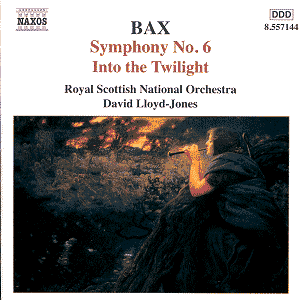I am reminded of David Lloyd-Jones’ remarks about Bax’s
Sixth Symphony in an interview for British Music Society News.
He said, "I think the 6th Symphony is the most cogent [of Bax’s
seven symphonies]. It contains a lot of fastish music which Bax pulls
off very well. It has a different tone and inhabits a different world
to the rest of the symphonies. But so does the 7th Symphony which is
full of good music, though it is not so personal and therefore not as
persuasive as the 6th." Vernon Handley, when asked what was his
favourite Bax work replied, "As an orchestral conductor, the works
that flood through the mind immediately are, of course, all the symphonies,
tone poems and concerti but I think probably the 6th Symphony is my
favourite because of its remarkable control of form and its very tight
argument. It addresses a very big universal problem as well as a personal
one for Bax. It is an apocalyptic symphony and Bax was obviously very
moved - and moved intellectually - while writing it."
Apocalyptic indeed, and Lloyd-Jones in this penultimate
recording of his acclaimed Bax symphonies cycle for Naxos (only the
Seventh Symphony remains to be published) brilliantly realises the cataclysmic,
the primordial elements of this symphony of conflicts – conflicts of
tonality, rhythm and mood etc., conflicts first stated in Bax’s First
Symphony and perpetuated and developed throughout the set (the symphonies
may be viewed as a continuing saga as first highlighted by Colin Scott-Sutherland
in his ground-breaking biography) and only resolved in the dying pages
of this Symphony and in the comparative calm of the Seventh.
Lloyd-Jones’ opening pages are bleak, preluding a tempestuous
view of the first movement. Bax worked on this symphony huddled in his
hotel room at Morar near the end of the Road to the Isles overlooking
the Hebridean islands of Eigg and Rhum in the depths of winter. (Cannily
he chose a hotel adjoining the railway station so that he could easily
return to civilization if necessary). The music of this first movement
(and elsewhere), in Lloyd-Jones’ reading, suggests to me, having visited
Morar, the special, swiftly changing winter weather and light up there;
one minute peaceful, the next wild and turbulent. One can imagine deep
turbulent waters with huge waves tossed and whipped by veering gale
force winds as they surge and race shorewards. But so does Bryden Thomson
in his London Philharmonic reading (on Chandos CHAN 8586) although his
reading is that much more romantic and is captured in superior sound.
(Both conductors take 9:45 mins to perform this movement).
Thomson allows the lovely second movement 10:39 mins
to breathe more whereas Lloyd-Jones moves the music forward through
9:45 mins. Much has been written about Bryden Thomson’s relaxed tempi
in these Bax symphonies and generally I would agree but in this instance
I prefer to dawdle and admire the scenery, so enjoying all the more
the dramatic contrast in the opening and tripartite closing movements
– not that Thomson eschews dramatic tension in this movement, anyway
and conversely there is much beauty in Lloyd-Jones’ version. Both he
and Lloyd-Jones in their different accentuations take a bleak view of
that telling slow march tread towards the end of the movement (with
Lloyd-Jones omitting the tambourine according to Bax’s revision).
Lloyd-Jones’ forceful and tremendously exciting reading
of the complex third movement [marked: Introduction (Lento moderato)
– Scherzo and Trio (Allegro vivace – Andante semplice) – Epilogue (Lento)]
is accomplished in 16:55 mins, whereas Thomson spends 19:01. After the
wistful long-breathed clarinet solo, he opts for a softer, more picturesque
Introduction, Lloyd-Jones sculpts a rockier edifice. Lloyd-Jones builds
a huge, shattering apocalyptic climax at the end of the Scherzo before
final resolution is reluctantly won against diminishing protestations,
signalled by those ethereal horns. Thomson’s climax is not so threatening
and his longer Epilogue is a relatively easier and, one feels, a more
complete resolution.
In conclusion, I am going to resolutely sit on the
fence. I admire both Bryden Thomson’s recording and this new Lloyd-Jones
version of this marvellous symphony. It all depends on one’s mood. And
one must not forget Norman Del Mar’s remarkable recording, with the
New Philharmonia Orchestra, made for Lyrita – thrilling and atmospheric
- issued in 1967 on LP only and alas no longer available
The fill-ups on this album are equally inviting. Into
the Twilight is an early work compiled from material that Bax originally
conceived for an opera based on the legendary Irish heroine, Deirdre
of the Sorrows (Bax had previously written a five-act play that would
have been the source of the play’s libretto). Bax wrote that it ‘seeks
to give a musical impression of the brooding quiet of the Western Mountains
at the end of twilight and to express something of the timelessness
and hypnotic dream which veils Ireland at such an hour." Lloyd-Jones
spins fairy enchantment. He also provides a nicely atmospheric reading
of Summer Music written in London in 1921 and revised for publication
in 1923. Bax wrote of it: ‘The piece, a musical description of a hot
windless June mid-day in some wooded place in Southern England, is lyrical
throughout. During the greater part of it the strings are occupied in
providing a murmurous accompaniment to the pastoral reveries of the
various wind instruments, and not until near the end is there any great
climax of sound."
A thrilling, evocative reading of Bax’s finest symphonic
accomplishment.
Ian Lace
See also review
by Rob Barnett

![]() Royal Scottish National
Orchestra/David Lloyd-Jones
Royal Scottish National
Orchestra/David Lloyd-Jones ![]() NAXOS 8.557144 [57.46]
NAXOS 8.557144 [57.46]